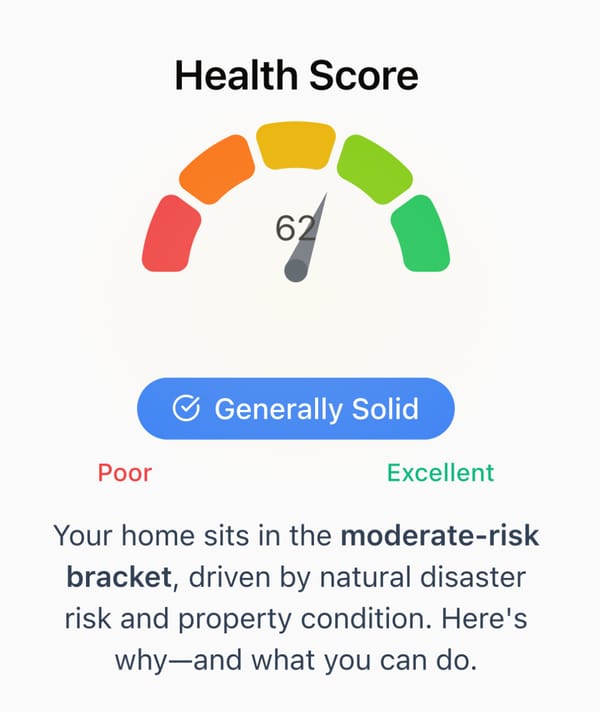Shifting Ground: Why Landslide & Soil-Stability Risk Belongs in Every Property Checklist

TL;DR
• 44 % of U.S. homes sit in terrain that the USGS flags as potentially landslide-prone. (Landslide Danger Looms For 44% Of U.S. Homes - Yahoo Finance)
• Annual economic losses exceed $1 billion, with some estimates topping $2 billion when indirect costs are counted. (Economic Losses and Fatalities Due to Landslides - USGS.gov, Landslides May Be Inevitable, But They're Not Yet Predictable)
• Landslides kill 25-50 Americans each year—more than hurricanes in some seasons. (How many deaths result from landslides each year? - USGS.gov)
1. Landslides Aren’t Just Mountain Problems
Mud- and rock-slides hit suburbs, highway cuts, even waterfront fill. The triggers:
| Trigger | Example | Why It’s Increasing |
|---|---|---|
| Intense rainfall | Atmospheric-river events in CA & WA | Warmer air = higher moisture capacity |
| Wildfire scar erosion | Colorado Front Range, 2023 | Vegetation loss → soil cohesion loss |
| Cut-and-fill grading | Hillside subdivisions in TN & AL | Rapid development outpaces geotech review |
Bottom line: if your parcel sits on slope ≥ 15 %, fill dirt, or ancient slide debris, escrow can crumble faster than the hillside.
2. The Hidden Cost Curve
| Cost Item | Typical Range | Notes |
|---|---|---|
| Emergency debris removal | $15 k–$60 k | Not always covered by standard HO policy |
| Retaining wall / soil nail system | $30 k–$150 k | Engineering + steel prices volatile |
| Foundation underpinning | $8 k–$25 k per pier line | Required if house shifts > ¼ in. |
| Insurance premium hike | 20 %–200 % | Some carriers now surcharge “Very-High Slope Hazard” ZIPs |
One slope failure can erase a decade of equity—or kill the sale when the buyer’s lender balks at the geotech report.
3. Map Gaps: Why County Disclosures Fall Short
- County hazard maps rely on historic slide inventories, missing potential future failures.
- FEMA flood FIRMs ignore hillslope hydrology entirely.
- Parcel-level grading permits often remain on paper; inspections can lag final occupancy by months or years.
Without a unified data lens you’re guessing blind on one of the most expensive structural risks a homeowner can face.
Want to see the data on your own address?
Run a FREE sample Property Insights report
4. Example Snapshot
Case ID: PI-OR-24-0461 | Portland West Hills
• Lot slope: 22 % | LSS: 82 (High)
• Found undocumented fill depth ≥ 6 ft behind foundation.
• Buyer negotiated $45 k credit to install tie-back retaining wall + subsurface drain before close.
• Deal salvaged; lender required engineer letter citing PI-101 report.
6. Stakeholder Action Plan
| Role | Immediate Move | Rationale |
|---|---|---|
| Buyers | Order an LSS early—before appraisal—to avoid surprise lender conditions. | Geotech delays can blow contingency windows. |
| Inspectors | Photograph cracks, tilting retaining walls; flag LSS ≥ 60. | Adds tangible differentiation vs. basic visual inspection. |
| Agents | Pull USGS + PI-101 overlays for hillside listings; price accordingly. | Transparency averts post-closing litigation. |
7. Takeaway
Gravity never sleeps—and neither should your due diligence. A gorgeous view lot can mask loose fill, creeping clay, and six-figure repair risk. Property Insights 101 stitches topography, soil science, and climate-driven rainfall trends into a single Landslide Susceptibility Score so you can buy (or list) with eyes wide open.
Next in queue: Energy-Efficiency Myths—Why a Brand-New Furnace Won’t Slash Bills if Your Ducts Leak Like A Sieve.
Want to see the data on your own address?
Run a FREE sample Property Insights report in 30 sec—no credit card, no spam.





